So you want to minimize finger movement when you type, but don’t have three grand to drop on an old DataHand, or enough time to build the open-source lalboard? Check out these two concept keebs from [SouthPawEngineer], which only look like chord boards.
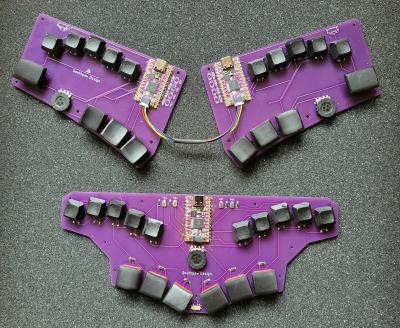 Every key on the home row is a five-way switch — like a D-pad with straight down input. [SouthPawEngineer] has them set up so that each one covers a QWERTY column. So like, for the left pinky switch, up is Q, right is A, down is Z, and left is 1. Technically, the split has 58 keys, and the uni has 56.
Every key on the home row is a five-way switch — like a D-pad with straight down input. [SouthPawEngineer] has them set up so that each one covers a QWERTY column. So like, for the left pinky switch, up is Q, right is A, down is Z, and left is 1. Technically, the split has 58 keys, and the uni has 56.
Both of these keebs use KB2040 boards, which are Adafruit’s answer to the keyboard-building craze of these roaring 2020s. These little boards are of course easy to program with CircuitPython, which supports KMK, an offshoot of the popular QMK. Thanks for the tip, [foamyguy]!
New Keebs: The Glove80 Is One Size Fits All
As much as I love my Kinesis Advantage, it is an ideal keyboard for home use and not necessarily anywhere else. There’s no way I can go back to a rectangle unless I want my repetitive stress injury to resurface, so I need an ergonomic split for outside the house. Pretty much any split would be more portable than the Kinesis, but not all splits are created equal. Thus far, I have found the ErgoDox too big for my hands, and I still haven’t got my Dactyl working all the way, so there’s no data there. Ergo, I am more than tempted by the Glove80, a low-profile split which is available via fully-funded but still-active Kickstarter. It has Kailh Chocs, POM keycaps, and uses a pair of nRF52840s.
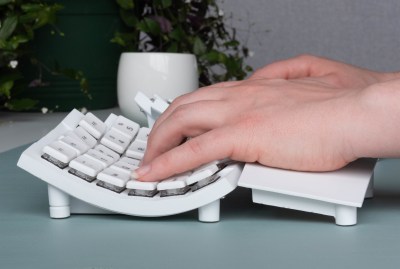 The designers behind Glove80 are enthusiasts — an entrepreneur and and engineer with 18 years of ergo keyboard use under their fingers. They did over 500 ergo experiments and built really cool-looking modular test rigs in order to build a keyboard that is purported to be comfortable for all hand sizes. They weren’t originally planning to commercialize this keyboard, but luckily, someone convinced them it should be shared with the world.
The designers behind Glove80 are enthusiasts — an entrepreneur and and engineer with 18 years of ergo keyboard use under their fingers. They did over 500 ergo experiments and built really cool-looking modular test rigs in order to build a keyboard that is purported to be comfortable for all hand sizes. They weren’t originally planning to commercialize this keyboard, but luckily, someone convinced them it should be shared with the world.
This Bluetooth split has 80 low-profile keys (hence the name), all of which are the same size — 1u. That makes it easy to swap layouts and keycaps however you like. The most attractive thing about this keyboard is choice: currently, you can choose red, brown, or white switches, and there is a stretch goal in place for a 4th switch type that will be voted upon.
A Keeb Designed By Physics
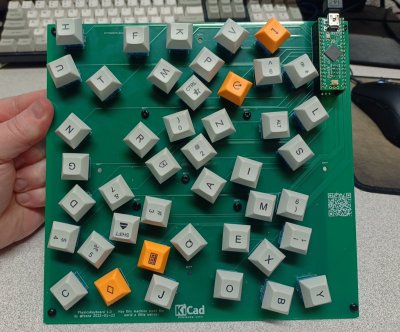 As [Foone] pointed out on Twitter (ThreadReader version) the other day, keyboard layouts as we know them have descended from typewriters and their operational limitations. But we can throw all that out the window since we have digital keyboards now.
As [Foone] pointed out on Twitter (ThreadReader version) the other day, keyboard layouts as we know them have descended from typewriters and their operational limitations. But we can throw all that out the window since we have digital keyboards now.
To that end, [Foone] let physics design this layout (if you can call it that) by essentially putting all the keys in a virtual jar with some spacer spheres, shaking it, and letting the letters, symbols, and modifiers fall where they may.
If you think typing on this would be a nightmare, consider the wiring for a minute. [Foone] used a Teensy++ 2.0, which has 45 GPIO pins, so there’s no need for a matrix or diodes. This is essentially an expensive joke, but there is some truth in it. If nothing else, let this funny exercise serve as an inspiration — one that gives you permission to put ergonomics first, or whatever butters your muffin when it comes to keyboard design. Thanks for the tip, [J. Peterson]!
Historical Clackers: Ballpoint Typewriters Will Draw You In
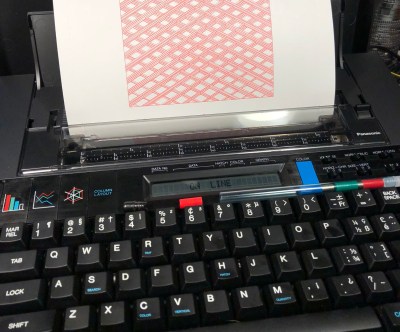 Serial keyboard designer [deʃhipu] tipped me off to this old Twitter thread from [Paul Rickards] (ThreadReader version) about ballpoint typewriters, which are kind of like the love child between a word processor and a pen plotter. Under normal circumstances, the user types on the keyboard and the characters appear on a small screen about 20 at a time, which gives a chance to correct mistakes before it sends the words to the print head.
Serial keyboard designer [deʃhipu] tipped me off to this old Twitter thread from [Paul Rickards] (ThreadReader version) about ballpoint typewriters, which are kind of like the love child between a word processor and a pen plotter. Under normal circumstances, the user types on the keyboard and the characters appear on a small screen about 20 at a time, which gives a chance to correct mistakes before it sends the words to the print head.
When connected to a computer via RS-232 serial port, these machines can draw all sorts of things from graphs to graphic art using an Alps plotter mechanism and tiny ballpoint pens in red, blue, green, and black. There are a ton of nice pictures in the thread that show different makes and models throughout the years, so go check them out.
ICMYI: the Palm Portable Keyboard Goes Wireless
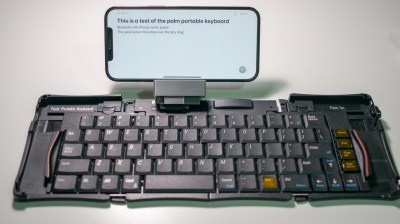 Okay, so you probably don’t have a Palm device anymore, but you almost certainly carry a smart phone around. Wouldn’t it be cool if you could use Palm’s revolutionary (at the time) foldy keyboard that collapses neatly to pocket size? Yeah it would.
Okay, so you probably don’t have a Palm device anymore, but you almost certainly carry a smart phone around. Wouldn’t it be cool if you could use Palm’s revolutionary (at the time) foldy keyboard that collapses neatly to pocket size? Yeah it would.
Well now you can, thanks to [Xinming Chen] and their tidy little Bluetooth adapter. It is essentially an Adafruit Feather nRF52840 and a voltage level inverter that translates RS-232 from the keyboard into TTL for the Bluetooth host, all in a neat 3D-printed package that slides on to the keyboard’s connector and powers on with a tiny, hidden switch. What’s not to like? And you wouldn’t believe how cheap and abundant these origami inputs are on kee-bay. I got mine and left you all plenty.
Got a hot tip that has like, anything to do with keyboards? Help me out by sending in a link or two. Don’t want all the Hackaday scribes to see it? Feel free to email me directly.
















When will mechanical keyboard makers offer keycaps in smaller and larger sizes? Human hands come in many different sizes, but mechanical keycaps are all one size. You can only find miniature or oversized keys on specialty rubber membrane boards.
Every single attempt at an ergonomic keyboard fails to address the size of the keys themselves as a cause of repetitive stress. No matter how many different ways you choose to angle the key to anticipate natural movement, if the user’s fingers can’t easily reach the key then it’s not ergonomic for them.
Seriously, try comparing the size of your hands between your friends and family, and ask them how well they can type on a standard ANSI keyboard. You will find a strong correlation between skilled typists and large hands.
You could always model and print your own keycaps – I’ve considered a low end resin printer to print blank keycaps simply for the cost effectiveness of it.
If you stay with a flat keyboard you’re going to run into a brick wall with the spacing on the key switches, though it looks like we have a viable 3d printable key switch that uses magnets, so maybe you leverage that resin printer you picked up for keycaps and make smaller key switches as well.
It should be noted that concave ergonomic keyboards effectively reduce key spacing because they angle the keys toward each other. I have one that the effective spacing (corner to corner measurement between key caps) is 16mm vs the typical 19.05mm.
Kristina, thank you for mentioning Glove80. Awesome coverage, but just want to mention that Glove80 has three choices of key switches – red, white and brown. And if we do reach the stretch goal, a 4th choice that will be determined by the backers’ vote.
We have a very lively and fun discord group too at https://discord.com/invite/cdywSRX9qF, and making stuff together. Do please come and check it out.
Hi Kristina,
Thank you for featuring the Glove80! That’s really cool of you!
I’m involved in the Glove80 community (no affiliation with the MoErgo team, just a volunteer) and just wanted to point out that there’s a small mistake in the Glove80 description: It _does_ come with other switches than Choc Reds: There’s a choice between Red (linear), White (clicky), and Brown (tactile); (all Choc v1s) : )
Have a great day!
I apologize for the error and for not seeing this sooner. Stephen contacted me and I corrected the article.
Kristina,
Thank you for mentioning Glove80; glad you like it. I would love to mention two of my most favourite things about Glove80:
– The curved 2-row 2-level thumb cluster that we did close to 200 experiments to get right. With this thumb cluster most users can actually easily access all 6 thumb keys, which I believe is a real game changer. This means it is now viable to move all the modifiers and common non-alpha keys like delete/backspace/space/enter to the thumb, and reduce the workload on the pinkie fingers. The thumb cluster is my biggest pride of Glove80.
– It runs the simply amazing opensource ZMK
— Stephen (co-designer of Glove80)
I did not know pen typewriters existed, I would really like one of these but hard to find in UK, pens may be a problem though, also a nice dot matrix printer, I know modern printers are fast and produce good graphics but old tech has a certain appeal with low cost per page and still legible 20 years hence.